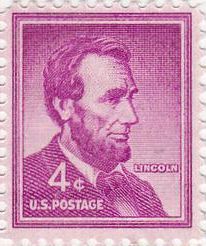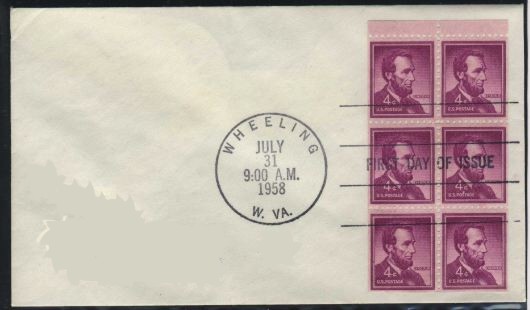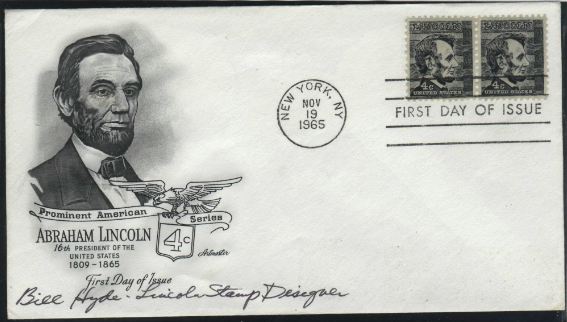Abraham Lincoln on Stamps – Regular Issues of the 1950s through the 1960s
Posted By Norman Gasbarro on March 1, 2013
Today, the regular Abraham Lincoln stamp issues will continue with an examination of the Liberty Series and the Prominent Americans Series which saw service from the mid-1950s through the mid-1970s.
Previously, here on this blog, the Presidential Series of 1938 was explained. In addition, on Tuesday last week, former presidents who were alive during all or part of the Civil War were depicted on the stamps on which they appeared – the only such regular stamp issues honoring them. Two other prior posts, Early Postage Stamps Honoring Abraham Lincoln and Postage Stamps Honoring Abraham Lincoln – Bureau of Engraving and Printing to 1909. discussed the early depiction of Abraham Lincoln on postage stamps.
The first stamp to be issued in the new Liberty Series in 1954 was a two-colored Statue of Liberty stamp in a 8 cent denomination (April 1954). It was soon followed by a 3 cent violet issue (June 1954) to meet the regular letter rate. As a result, the new series, which would replace the Presidential Issue of 1938, took on the theme of “Liberty,” and ensuing stamps issue depicted people, buildings, and monuments connected with this theme.
On 19 November 1954, a 4 cent stamp in this series was issued to honor Abraham Lincoln (stamp and First Day Cover shown above). By placing Lincoln on this lower value stamp in the series, it ensured that the portrait of this former Republican president would get good public exposure – much more so than on the 16 cent stamp of the Presidential Series on which he had been depicted for more than 15 years. This was also a more than subtle reminder that the Republicans had finally taken over the White House in 1953 after twenty years of control by the Democrats. However, the 3 cent rate remained the domestic letter until 1 August 1958, when, the rate was raised to 4 cents – and the Lincoln stamp of this series saw its most prolific usage on the regular, daily mail of all Americans – the first and only time that this has occurred.
In preparation for the raise in postage rates, the 4 cent Lincoln stamp was issued on 31 July 1958 in two popular formats – the coil (for machine dispensing and in rolls of 100 for personal and business use), and the booklet (mostly for personal use). The First Day Covers for these formats are shown above (the coil) and below (one “pane” from a booklet).
All of the individuals who were pictured on the Liberty Series, with one exception, were in the same basic design – a frame, a portrait, a single color, the denomination, and the name of the individual (sometime the full name and sometimes just the surname).
There are two controversial aspects to this series. The first is trite and does not apply to all the portrait designs – but does apply to enough designs to wonder whether it was done intentionally. Lincoln, a Republican, faces to the right, as does the other notable Republican president depicted, Theodore Roosevelt. Thomas Jefferson and Woodrow Wilson, both Democrats, face to the left. The second controversy was more serious, especially since Civil Rights was coming into the forefront in the 1950s. It involved the selection of Robert E. Lee as the subject of the 30 cent stamp of this series. Lee, who had taken up arms against the United States in the Civil War in defending both state’s rights and slavery, had previously appeared on a commemorative issue in 1949 – for the Bicentenary of Washington and Lee University in Lexington, Virgina – but had never before been considered for a regular issue postage stamp. There were other serious concerns about including Lee. No African American had ever appeared on a regular issue postage stamp of a series, and, other than Martha Washington, no woman had appeared. Women got their heroine with the inclusion of Susan B. Anthony as the 50 cent stamp in the Liberty Series. African Americans would have to wait until the next regular issue series to be included. The slight to Ulysses S. Grant also did not go unnoticed. Since the First Bureau of Engraving and Printing Issues of the 19th Century with the exception of one series which only depicted Washington and Franklin, Grant’s portrait had appeared in every series. Now, with the Liberty Series, he was to be replaced with the image of someone many considered to be a traitor – and the general credited with bringing the rebellion to an end and freedom to millions of those held in bondage, the one who accepted the surrender of Gen. Lee, had apparently lost his place in history.
Of course, the Democrats took over the White House in 1961, but it didn’t seem that they were in any rush to replace the Liberty Series with one honoring heroes from their party. Slowly, however, a new series began to emerge – one which had a Hodge-podge of designs with no two stamps having a common design element. On 7 January 1963, the domestic letter rate was raised to 5 cents and the Post Office issued a regular issue stamp with the portrait of George Washington in the 5 cent denomination. That stamp would be the main stamp seen on mail – thus replacing the 4 cent Lincoln of the Liberty Series. Since 4 cents was the new post card rate, a new stamp honoring Lincoln was produced (shown below) with his portrait against the background of a simulated log cabin.

Lincoln, although still appearing on a regular issue stamp that would see wide-spread usage, was relegated to a less-frequently used service – that of the post card.
The new series of regular-issue stamps that evolved in the mid-1960s, got the name “Prominent Americans,” and featured Frederick Douglass on the 25 cent issue, Lucy Stone on the 50 cent issue, Albert Einstein on the 8 cent issue, and John Kennedy on the 13 cent issue – in addition to an architect, an historian, an educator, a playwright, others and former presidents.
It was not until 21 October 1968 that the Robert E. Lee stamp was replaced – with a 30 cent stamp honoring John Dewey. It has to be noted that the Liberty Series of stamps was the one still in common usage during the centennial of the Civil War – and that the only two Civil War-era political personages represented were Lincoln and Lee. It was not until the centennial years were over that the Liberty Series was completely replaced with the Prominent Americans Series.
The United States was beginning to tout its diversity – both in who was portrayed on stamps and in the designs themselves. This was the last series of stamps in which the choice of stamp subjects supposedly had an element of politics involved through the workings of the Executive Branch. On 1 July 1971, the Post Office Department, as it had existed since the beginning of the Republic, ceased to exist as such and was replaced with the United States Postal Service. It was also the last time that the portrait of Lincoln would appear on a regular issue postage stamp of the United States.
The next part in this examination of Abraham Lincoln on stamps will begin explore the commemorate issues that recognized him and significant events in his presidency, including the Civil War. It will appear some time next month.
—————————-
Much of the information for this post was taken from Abraham Lincoln on Postage Stamps, privately published in 2000 as a companion to a stamp collection and exhibit that was displayed at a county historical society in Pennsylvania in conjunction with the 135th Anniversary of the Lincoln Assassination.
 ;
;








A portrait of Gen. Robert E. Lee had also appeared on the 4 cent issue of a 5-stamp commemorative series issued in 1937 in honor of the United States Army along with fellow Confederate General, Thomas “Stonewall” Jackson. This information was omitted from the original post.
I have an 8 1/2 x 11 1st day of issue dtd june 7 1983 of Lincoln with 5 stamps depicting battles plus 1st day of issue of grant dtd nov 3 1938 plus 1 of JFK dtd may 29 1964 are they worth anything? Thank You for any help you can give me in this matter, Don
So what aer they worth?
I think I have an error postage stamp the 4cent 1954 Lincoln I do not know of any . I can send a pic.